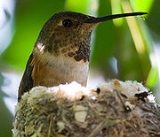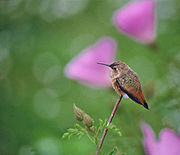
Allen's Hummingbird
Encyclopedia
The Allen's Hummingbird, Selasphorus sasin, is a species of hummingbird
.
The Allen's Hummingbird is a small bird, with mature adults reaching only 3 to 3½ inches (75 to 90 mm) in length. The male Allen's has a green back and forehead, with rust-colored rufous flanks, rump, and tail. The male's throat is also an iridescent orange-red. The female and immature Allen's Hummingbirds are similarly colored, but lack the iridescent throat patch, instead having a series of speckles on their throat. Females are mostly green, featuring rufous colors only on the tail, which also has white tips. The immature Allen's Hummingbirds are so similar to the female Rufous Hummingbird
that the two are almost indistinguishable in the field. Both species' breeding seasons and ranges are common factors used to differentiate between the two species in a particular geographical area.
The Allen's Hummingbird is common only in the brushy woods, gardens, and meadows of coastal California
from Santa Barbara north, and a minuscule portion of lower Oregon
. The nominate race of Allen's Hummingbird S.s. sasin is migratory
, and winters along the Pacific coast of central Mexico
. A second race S.s. sedentarius is a permanent resident on the Channel Islands off southern California. This population colonized the Palos Verdes Peninsula of Los Angeles County in the 1960s and has since spread over much of Los Angeles and Orange Counties.
The courtship flight of the male Allen's Hummingbird is a frantic back and forth flight arc of about 25 feet (10 m) similar to the motion of a swinging pendulum, followed by a high-speed dive from about 100 feet (30 m). The male is also highly aggressive and territorial. Hot-tempered despite its diminutive stature, a male Allen's Hummingbird will chase any other males from its territory, as well as any other hummingbird species, and they have even been known to attack and rout predatory birds several times larger than themselves such as kestrels
and hawk
s.
The Allen's Hummingbird constructs its nest out of plant fibers, down, and weed stems, coating the nest with lichen
s to give it structure. The nest is placed above ground on a tree branch or the stalk or stem of a plant. The female lays two white eggs, which she will incubate for 15 to 17 days. The young will leave the nest about three weeks after hatching. The mother will continue to feed the fledglings for several more weeks, then the young are left to fend for themselves.
Like all hummingbirds, the Allen's Hummingbird's high rate of metabolism requires it to feed frequently, about every hour. The Allen's Hummingbird drinks nectar from flowers, as well as eating any small insects it finds crawling around the flower blossom, which provide it with needed protein.
The common name commemorates Charles Andrew Allen (1841-1930), American collector and taxidermist.
A hybrid between this species and Anna's Hummingbird
has been described as Floresi's Hummingbird, "Selasphorus" floresii (Ridgway, 1909; Taylor, 1909).
Hummingbird
Hummingbirds are birds that comprise the family Trochilidae. They are among the smallest of birds, most species measuring in the 7.5–13 cm range. Indeed, the smallest extant bird species is a hummingbird, the 5-cm Bee Hummingbird. They can hover in mid-air by rapidly flapping their wings...
.
The Allen's Hummingbird is a small bird, with mature adults reaching only 3 to 3½ inches (75 to 90 mm) in length. The male Allen's has a green back and forehead, with rust-colored rufous flanks, rump, and tail. The male's throat is also an iridescent orange-red. The female and immature Allen's Hummingbirds are similarly colored, but lack the iridescent throat patch, instead having a series of speckles on their throat. Females are mostly green, featuring rufous colors only on the tail, which also has white tips. The immature Allen's Hummingbirds are so similar to the female Rufous Hummingbird
Rufous Hummingbird
The Rufous Hummingbird is a small hummingbird, about 8 cm long with a long, straight and very slender bill. The female is slightly larger than the male.-Description:...
that the two are almost indistinguishable in the field. Both species' breeding seasons and ranges are common factors used to differentiate between the two species in a particular geographical area.
The Allen's Hummingbird is common only in the brushy woods, gardens, and meadows of coastal California
California
California is a state located on the West Coast of the United States. It is by far the most populous U.S. state, and the third-largest by land area...
from Santa Barbara north, and a minuscule portion of lower Oregon
Oregon
Oregon is a state in the Pacific Northwest region of the United States. It is located on the Pacific coast, with Washington to the north, California to the south, Nevada on the southeast and Idaho to the east. The Columbia and Snake rivers delineate much of Oregon's northern and eastern...
. The nominate race of Allen's Hummingbird S.s. sasin is migratory
Bird migration
Bird migration is the regular seasonal journey undertaken by many species of birds. Bird movements include those made in response to changes in food availability, habitat or weather. Sometimes, journeys are not termed "true migration" because they are irregular or in only one direction...
, and winters along the Pacific coast of central Mexico
Mexico
The United Mexican States , commonly known as Mexico , is a federal constitutional republic in North America. It is bordered on the north by the United States; on the south and west by the Pacific Ocean; on the southeast by Guatemala, Belize, and the Caribbean Sea; and on the east by the Gulf of...
. A second race S.s. sedentarius is a permanent resident on the Channel Islands off southern California. This population colonized the Palos Verdes Peninsula of Los Angeles County in the 1960s and has since spread over much of Los Angeles and Orange Counties.
The courtship flight of the male Allen's Hummingbird is a frantic back and forth flight arc of about 25 feet (10 m) similar to the motion of a swinging pendulum, followed by a high-speed dive from about 100 feet (30 m). The male is also highly aggressive and territorial. Hot-tempered despite its diminutive stature, a male Allen's Hummingbird will chase any other males from its territory, as well as any other hummingbird species, and they have even been known to attack and rout predatory birds several times larger than themselves such as kestrels
American Kestrel
The American Kestrel , sometimes colloquially known as the Sparrow Hawk, is a small falcon, and the only kestrel found in the Americas. It is the most common falcon in North America, and is found in a wide variety of habitats. At long, it is also the smallest falcon in North America...
and hawk
Hawk
The term hawk can be used in several ways:* In strict usage in Australia and Africa, to mean any of the species in the subfamily Accipitrinae, which comprises the genera Accipiter, Micronisus, Melierax, Urotriorchis and Megatriorchis. The large and widespread Accipiter genus includes goshawks,...
s.
The Allen's Hummingbird constructs its nest out of plant fibers, down, and weed stems, coating the nest with lichen
Lichen
Lichens are composite organisms consisting of a symbiotic organism composed of a fungus with a photosynthetic partner , usually either a green alga or cyanobacterium...
s to give it structure. The nest is placed above ground on a tree branch or the stalk or stem of a plant. The female lays two white eggs, which she will incubate for 15 to 17 days. The young will leave the nest about three weeks after hatching. The mother will continue to feed the fledglings for several more weeks, then the young are left to fend for themselves.
Like all hummingbirds, the Allen's Hummingbird's high rate of metabolism requires it to feed frequently, about every hour. The Allen's Hummingbird drinks nectar from flowers, as well as eating any small insects it finds crawling around the flower blossom, which provide it with needed protein.
The common name commemorates Charles Andrew Allen (1841-1930), American collector and taxidermist.
A hybrid between this species and Anna's Hummingbird
Anna's Hummingbird
Anna's Hummingbird is a medium-sized hummingbird native to the west coast of North America. This bird was named after Anna Masséna, Duchess of Rivoli.-Description:...
has been described as Floresi's Hummingbird, "Selasphorus" floresii (Ridgway, 1909; Taylor, 1909).

External links
- Allen's Hummingbird photo
- Allen's Hummingbird videos on the Internet Bird Collection
- Allen's Hummingbird photo gallery VIREO
- Live nest webcam

